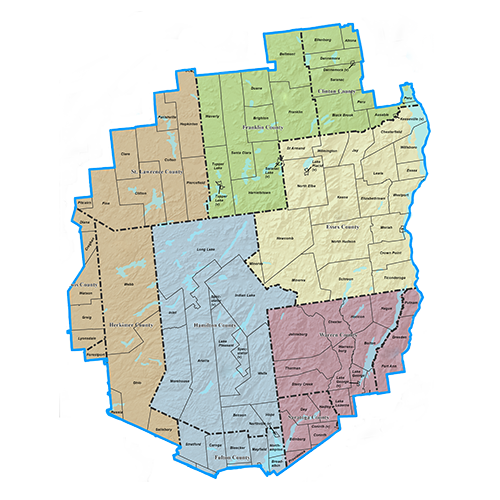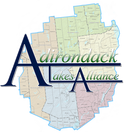Reducing salt usage in Lake George begins with you
By Kristen Rohne, Director of Education
Now that winter has arrived, we all will get reacquainted with the process of clearing the sidewalks, driveways and walkways around our homes and businesses to allow safe passage – but this year the LGA would like to ask you to make a few adjustments to your routine.
As we all know, the use of salt (or sodium chloride) on our properties (driveways, sidewalks and – for commercial property owners – parking lots) has become the routine way to manage a buildup of ice or hard-packed snow.
The relatively inexpensive price to purchase bags of salt makes it the go-to tool for many of us. Unfortunately, the low price and abundant use has meant an increase in the amount of sodium chloride in the Lake and in the watershed around the Lake. As you may know, excess salt in the watershed can disrupt freshwater ecosystems, contaminate the drinking water supply that is Lake George, kill vegetation, disturb wildlife, and damage infrastructure.
To put a halt to potential future problems, the Lake George Association and other partner organizations in the Lake George Watershed Coalition and the SAVE Lake George Partnership are focusing on reducing the amount of salt being added to the environment now.
For homeowners and business owners, there aren’t all that many cost-effective alternatives to using salt. So until a new product is identified, the key is reducing the amount of salt used; adopting best management practices; and applying the right material, at the right time, and in the right amount.
Everyone who lives in the Lake George watershed can help to reduce the overall amount of salt in the Lake by paying closer attention to winter maintenance habits:
Kristen Rohne is the Director of Education for the Lake George Association. The Lake George Association’s mission is to Protect Lake George Water and Educate for the Future. Kristen is also the Adirondack Lakes Alliance (ALA) Regional Director for Warren, Saratoga, and Washington Counties.
By Kristen Rohne, Director of Education
Now that winter has arrived, we all will get reacquainted with the process of clearing the sidewalks, driveways and walkways around our homes and businesses to allow safe passage – but this year the LGA would like to ask you to make a few adjustments to your routine.
As we all know, the use of salt (or sodium chloride) on our properties (driveways, sidewalks and – for commercial property owners – parking lots) has become the routine way to manage a buildup of ice or hard-packed snow.
The relatively inexpensive price to purchase bags of salt makes it the go-to tool for many of us. Unfortunately, the low price and abundant use has meant an increase in the amount of sodium chloride in the Lake and in the watershed around the Lake. As you may know, excess salt in the watershed can disrupt freshwater ecosystems, contaminate the drinking water supply that is Lake George, kill vegetation, disturb wildlife, and damage infrastructure.
To put a halt to potential future problems, the Lake George Association and other partner organizations in the Lake George Watershed Coalition and the SAVE Lake George Partnership are focusing on reducing the amount of salt being added to the environment now.
For homeowners and business owners, there aren’t all that many cost-effective alternatives to using salt. So until a new product is identified, the key is reducing the amount of salt used; adopting best management practices; and applying the right material, at the right time, and in the right amount.
Everyone who lives in the Lake George watershed can help to reduce the overall amount of salt in the Lake by paying closer attention to winter maintenance habits:
- Shovel early and often: It stands to reason that when you remove snow and ice by shoveling, you’ll need less salt and the de-icing material will be more effective. Begin your cleanup work as early as you can and keep up with the snowfall (unless freezing rain is forecast to follow the snow) so the sun can get at the pavement/sidewalk and melt it away. You may even decide that salt isn't needed.
- Use an ice chipper: A specialized ice-chopping tool (not an ice pick) will allow you to work faster and more efficiently removing ice or a hard buildup of snow than a standard snow shovel.
- Apply only what’s needed: Sprinkle de-icing material on icy areas only, and follow the manufacturer’s instructions for working temperatures and application rates. Winter salt is most effective between 32 degrees F and 10 degrees F. If the temperature is above or below that, you can consider alternatives such as using a small amount of sand for traction, or chopping and removing the built up snow/ice with an ice chipper or shovel.
- Apply smartly: Keep salt application away from any storm drain, or where melted runoff can mix with salt and then flow into a storm drain. In many communities, storm drains lead directly into the Lake.
- Reposition downspouts: Make sure downspouts are pointed away from paved (or other hardened) areas so that water isn’t draining onto your walkways or driveways where it can refreeze.
- Reposition snow piles: Shovel unsalted snow to lower areas of your property or onto lawns to direct melting snow away from paved areas.
- Do your homework: Research de-icing materials before you purchase them to determine which is best for your specific property and need. Not all products have the same ingredients. Consider purchasing a de-icier that is chloride free.
Kristen Rohne is the Director of Education for the Lake George Association. The Lake George Association’s mission is to Protect Lake George Water and Educate for the Future. Kristen is also the Adirondack Lakes Alliance (ALA) Regional Director for Warren, Saratoga, and Washington Counties.


 RSS Feed
RSS Feed
